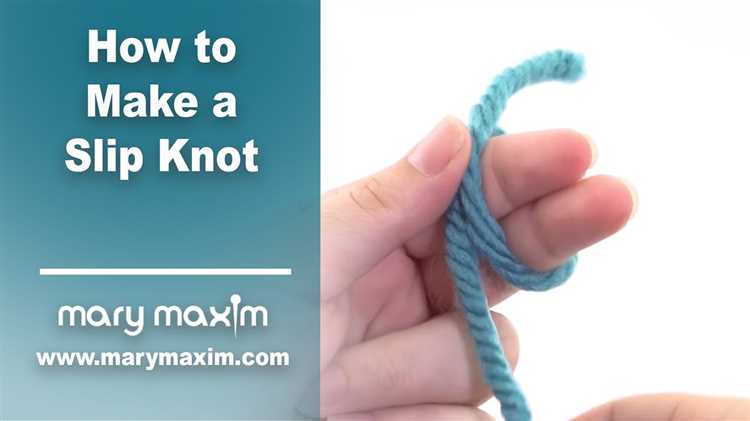Knitting is a popular hobby that has been enjoyed by people of all ages for centuries. Whether you’re a beginner or an experienced knitter, one of the first skills you need to learn is how to make a slip knot. A slip knot is the foundation of your knitting project, allowing you to create a loop that will hold your stitches securely on your knitting needle.
To make a slip knot, you only need a few basic supplies: yarn and knitting needles. Start by holding the end of the yarn in your hand, leaving a tail of about 6 inches. Hold the yarn between your thumb and index finger so that it forms a loop. Take the tail end of the yarn and cross it over the loop, creating a pretzel shape.
Next, take the tail end of the yarn and bring it through the loop, creating a new loop. Pull the tail end of the yarn tight to secure the knot. Congratulations, you’ve just made a slip knot! Now you’re ready to start your knitting project.
Intro: Why a Slip Knot is Essential for Knitting
When it comes to knitting, every project starts with a slip knot. This seemingly simple knot is actually a crucial foundation for beginning any knitting project. It creates a loop that can be easily adjusted and tightened, allowing you to control the tension of your stitches.
The slip knot serves as the first stitch on your knitting needle and provides a starting point for casting on additional stitches. It’s essential for maintaining the correct tension and ensuring that your stitches are evenly distributed along the knitting needle.
Not only does the slip knot help to create a secure foundation for your knitting, but it also allows you to easily join a new ball of yarn or change colors in your project. By starting with a slip knot, you can easily add or subtract stitches as needed while keeping your work in progress stable.
Learning how to make a slip knot is an essential skill for every knitter, whether you’re a beginner or an experienced crafter. It’s a simple technique that sets the stage for successful knitting and allows you to create beautiful, professional-looking projects.
In the following step-by-step guide, we’ll walk you through the process of creating a slip knot for knitting and provide helpful tips and tricks along the way. Once you’ve mastered this basic knitting skill, you’ll be ready to tackle a wide range of patterns and projects with confidence.
Step 1: Prepare your Yarn
Before you can start making a slip knot for knitting, you need to prepare your yarn. Here’s what you need to do:
- Choose your yarn: Select a yarn that is suitable for your knitting project. Consider the weight, fiber content, and color of the yarn.
- Find the end: Unravel the yarn from the skein or ball until you find the end. Keep the rest of the yarn organized and tangle-free.
- Measure your yarn: Determine the length of yarn you need for your project. You can measure it against a ruler, or estimate based on the pattern or project instructions.
- Wind your yarn: If your yarn is in a skein, you’ll need to wind it into a ball or cake. This will help prevent tangling and make it easier to work with. You can use a yarn winder or wind it by hand.
Once you have prepared your yarn, you’re ready to move on to the next step and learn how to make a slip knot for knitting.
Step 2: Create the Slip Knot Loop
After you have prepared your yarn, you can start creating the slip knot loop, which will be the first stitch of your knitting project. Follow these steps:
- Hold the end of the yarn in your right hand, leaving a tail that is about 6 inches long. This tail will later become part of your knitting project.
- Place your left hand over the yarn, about 4 inches away from the end.
- Using your right hand, bring the end of the yarn over your left hand to create a loop.
- Pass the end of the yarn through the loop from underneath, pulling it tight. This forms a slip knot.
Make sure the slip knot is not too tight or too loose. It should be just tight enough to slide along the yarn easily.
Now you have successfully created a slip knot, which will serve as the foundation for your knitting project. With this knot in place, you are ready to move on to the next step and start knitting!
Step 3: Tighten the Slip Knot
After creating the slip knot, the next step is to tighten it properly. This is important to ensure that it is secure and will not slip off later during knitting.
- Hold the tail end of the yarn with your non-dominant hand. This will prevent the slip knot from loosening while you tighten it.
- Using your dominant hand, gently pull the working end of the yarn (the end connected to the ball of yarn) to tighten the loop around the tail end.
- Continue tightening the slip knot until it is snug, but not too tight that it cannot be easily undone later.
Make sure to check that the slip knot is secure by gently tugging on the working end of the yarn. It should not come undone or loosen excessively.
Once the slip knot is tightened and secure, you are ready to proceed with your knitting project!
Step 4: Check the Tension
Once you have made a slip knot and cast on your stitches, it’s important to check the tension of your knitting. Tension refers to how tightly or loosely you are knitting.
To check the tension, hold your knitting needle with the stitches in your left hand and pull the yarn gently away from your work. You should be able to see the individual stitches clearly and there should not be any excessive tightness or looseness.
If your tension is too tight, your fabric may be difficult to work with and the stitches may not be even. To adjust the tension, you can try using a larger needle size or loosening your grip on the yarn.
If your tension is too loose, your fabric may be too stretchy and the stitches may be uneven. To adjust the tension, you can try using a smaller needle size or tightening your grip on the yarn.
Checking the tension is an important step in knitting as it ensures that your finished project will turn out the way you want it to. It may take some practice to achieve the desired tension, so don’t be discouraged if it doesn’t come easily at first. With time and experience, you’ll be able to knit with the perfect tension for your project.
Step 5: Adjust the Slip Knot if Necessary
After creating the slip knot in Step 4, you may find that it is too loose or too tight for your knitting project. Don’t worry, it’s easy to adjust the slip knot to the perfect size!
To make the slip knot smaller, simply pull on the yarn tail while holding the working end of the yarn. This will tighten the loop and make it smaller.
If the slip knot is too tight, gently loosen it by pulling on the working end of the yarn. Be careful not to pull too hard, as this can distort the shape of the loop.
Continue adjusting the slip knot until it is the desired size. You want it to be snug enough that it won’t come undone while knitting, but not so tight that it’s difficult to work with.
Once you have adjusted the slip knot, you are ready to move on to the next step in your knitting project. Congratulations!
Step 6: Use the Slip Knot to Start Knitting
Now that you have created a slip knot, you can use it to start knitting your project. Here is how you can do it:
- Hold the slip knot in your left hand, making sure the tail is hanging down.
- Insert the knitting needle into the slip knot from left to right, with the needle tip pointing towards the right.
- Tighten the slip knot by pulling on both the working yarn and the tail. Make sure it is snug, but not too tight.
- Hold the knitting needle with the slip knot in your right hand and the empty needle in your left hand.
- With your right hand, bring the working yarn over the top of the right-hand needle, forming a loop.
- Insert the right-hand needle into the loop formed by the working yarn and pull it through the slip knot.
- You now have a new stitch on the right-hand needle.
- Repeat steps 5-7 until you have the desired number of stitches on your right-hand needle.
Congratulations! You have successfully used the slip knot to start knitting. Now you can continue knitting your project using your preferred stitch pattern. Enjoy your knitting journey!
FAQ:
What is a slip knot in knitting?
A slip knot is a basic knot that is used to start a knitting project. It is used to secure the yarn to the knitting needle and create the first stitch.
Why is it important to make a slip knot before knitting?
Making a slip knot before knitting is important because it helps to secure the yarn to the knitting needle and create the first stitch. Without a slip knot, the yarn would not be properly attached to the needle and you would not be able to start knitting.
What kind of yarn is best for making a slip knot in knitting?
Any type of yarn can be used to make a slip knot in knitting. The important thing is to choose a yarn that is compatible with the project you are working on in terms of weight and fiber content.
Can you use a slip knot for any knitting project?
Yes, a slip knot can be used for any knitting project. It is the standard way to start a knitting project and create the first stitch.
Is it possible to undo a slip knot in knitting if I make a mistake?
Yes, it is possible to undo a slip knot in knitting if you make a mistake. Simply pull on the loose end of the yarn to unravel the knot and start again.

